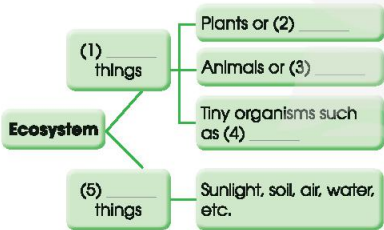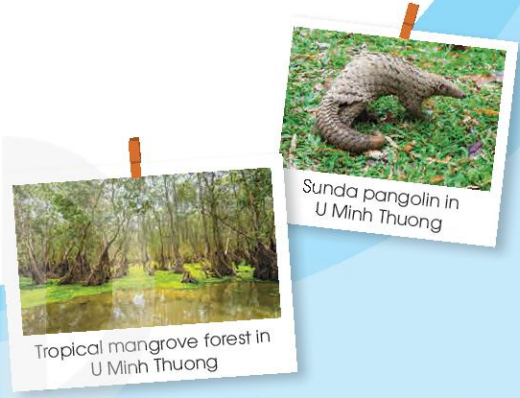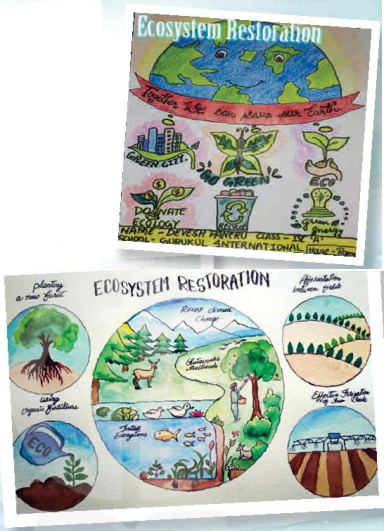Giải SGK, SBT Unit 10. The ecosystem Global Success
Giải SGK, SBT Unit 10 Global Success
2. Read the conversation again and decide whether these statements are true (T) or false (F).
(Đọc đoạn hội thoại một lần nữa và quyết định xem những câu này là đúng (T) hay sai (F).)
|
|
T |
F |
|
1. Nam went to Cuc Phuong National Park two weeks ago. |
|
|
|
2. In an ecosystem, plants, animals, and other living and non-living things form a community. |
|
|
|
3. We are losing a large number of ecosystems around the world. |
|
|
4. Use the words in the box to form compound nouns mentioned in 1. Match them with the meanings below.
(Sử dụng các từ trong hộp để tạo thành các danh từ ghép được đề cập trong phần 1. Nối chúng với các nghĩa bên dưới.)
|
raw |
climate |
change |
resources |
|
park |
natural |
national |
materials |
|
1. a change in the earth's weather conditions |
__________ |
|
2. things that exist in nature and can be used by people |
__________ |
|
3. land protected by the government because of its natural beauty or special history |
__________ |
|
4. basic materials used to make products |
__________ |
Plants and animals (Thực vật và động vật)
1. Match the words and phrase with their meanings.
(Nối các từ và cụm từ với ý nghĩa của chúng.)
|
1. native (adj) |
a. a group of animals or plants that have similar characteristics |
|
2. tropical forest (np) |
b. the protection of the natural environment |
|
3. species (n) |
c. any animal that gives birth to live young, not eggs, and feeds its young on milk |
|
4. conservation (n) |
d. thick forest that grows in the hot parts of the world |
|
5. mammal (n) |
e. existing naturally in a place |
Compound nouns (Danh từ ghép)
1. Use the words in the box to make five compound nouns.
(Sử dụng các từ trong hộp để tạo thành năm danh từ ghép.)
|
endangered |
nature |
life |
rain |
vocational |
|
species |
reserve |
expectancy |
forest |
school |
2. Work in pairs. Use the words in the box to make compound nouns. Then make sentences with them.
(Làm việc theo cặp. Sử dụng các từ trong hộp để tạo danh từ ghép. Sau đó đặt câu với chúng.)
|
wild |
swim |
life |
level |
warm |
|
mobile |
sea |
globe |
pool |
phone |
Example: There are many factors that contribute to global warming.
(Có nhiều nhân tố góp phần vào sự nóng lên toàn cầu.)
Ways to protect local biodiversity
(Các biện pháp bảo vệ đa dạng sinh học)
1. Look at the table below. Which of the following are ways to protect local biodiversity? Tick ✔ the correct boxes. Add two more if you can.
(Nhìn vào bảng dưới đây. Những cách nào sau đây là những cách để bảo vệ đa dạng sinh học ở địa phương? Đánh dấu ✔ vào các ô đúng. Thêm hai cái nữa nếu bạn có thể.)
|
1. banning the hunting of wild animals |
|
|
2. planting local trees, flowers, and other plants |
|
|
3. promoting mass tourism |
|
|
4. educating people about the importance of biodiversity |
|
|
5. increasing your carbon footprint |
|
3. Listen again and decide whether the statements are true (T) or false (F).
(Nghe lại và quyết định xem các câu đúng (T) hay sai (F).)
|
|
T |
F |
|
1. The threat to the earth’s biodiversity comes from human activities. (Mối đe dọa đối với đa dạng sinh học của trái đất đến từ các hoạt động của con người.) |
|
|
|
2. Nearly half of the world’s forests have been cut down. (Gần một nửa diện tích rừng trên thế giới đã bị đốn hạ.) |
|
|
|
3. The disappearance of some species may cause problems to the food chain. (Sự biến mất của một số loài có thể gây ra vấn đề cho chuỗi thức ăn.) |
|
|
|
4. The health of human beings does not depend on a healthy ecosystem. (Sức khỏe của con người không phụ thuộc vào một hệ sinh thái lành mạnh.) |
|
|
An opinion essay about spending more money on restoring local ecosystems
(Một bài luận ý kiến về việc tiêu tiền cho việc giữ gìn hệ sinh thái địa phương)
1. Work in groups. Discuss and decide whether the following ideas are for or against restoring local ecosystems.
(Làm việc nhóm. Thảo luận và quyết định xem những ý tưởng sau đây ủng hộ hay phản đối việc khôi phục các hệ sinh thái địa phương.)
|
IDEAS |
For |
Against |
|
1. It is more important to invest in healthcare and education. |
|
|
|
2. Air and water pollution are affecting our health. |
|
|
|
3. There are more serious problems such as unemployment and poverty. |
|
|
|
4. Many plant and animal species are disappearing. |
|
|
|
5. Cutting down forests is causing floods and other natural disasters. |
|
|
|
6. Ecosystems can restore themselves naturally. |
|
|
1. Read the text and tick (✓) the correct project in the table.
(Đọc văn bản và đánh dấu (✓) vào dự án đúng trong bảng.)
PROTECTING ECOSYSTEMS - IDEAS FROM AROUND THE WORLD
The healthier our ecosystems are, the healthier our planet and its people become. Ecosystem restoration can help end poverty, fight climate change, and prevent loss of flora and fauna on every continent and in every ocean. Below are two examples of successful ecological projects.
The Great Green Wall
The goal of this project is to create the largest living structure on the planet. The plan is to restore 100 million hectares of damaged land, limit the amount of carbon dioxide and create 10 million green jobs in Africa. This will provide rich land, food security, and improve the region’s ability to deal with climate change. Since its launch in 2007, Ethiopia and Nigeria have restored millions of hectares of land, and Senegal has planted more than 10 million trees.
Belize Barrier Reef
The Belize Barrier Reef was once described as the most amazing reef in the West Indies. It is home to a large diversity of plants and animals. Itis Belize’s top tourist destination, popular for scuba diving and snorkelling, and a UNESCO Natural World Heritage Site. Between 2009 and 2018, it was declared endangered because of pollution and the destruction of its ecosystems. However, because of conservation efforts, a large part of the reef is now protected. There are seven marine reserves. Belize has also stopped oil drilling near the Barrier Reef, banned plastic products, and created ‘no-take zones’, where removing plants and animals is not allowed.

|
|
The Great Green Wall |
Belize Barrier Reef |
|
1. It is a marine ecosystem of rich biodiversity. |
|
|
|
2. Its aim is to build the world’s biggest living structure. |
|
|
|
3. Millions of trees have been planted in several African countries. |
|
|
|
4. The government has taken measures to restore and protect the ecosystem |
|
|














